Yesterday I set out to make a cassoulet-inspired dish, without sacrificing my entire Saturday to the process. Anyone who has been reading this blog knows that I’m in love with peasant / comfort food. My problem with many cassoulets I’ve had in restaurants, even very reputable ones, is how dry they tend to be. I’ve read Julia Child’s cassoulet recipe in Mastering the Art of French Cooking, but always procrastinate taking it on because of the time involved. Here is one attempt to solve both those problems, and I admit to being very happy with the result.
The post is long because I’ve gone into some detail, but the actual time involved was quite efficient.
Peasant Bean Stew
3/4 lb dried red nightfall beans (or great northern)
1 bunch parsley, tied with kitchen string
4 carrots. 2 whole, 2 chopped
2 celery stalks
4 sweet italian sausages (4″ in length)
4 or 5 slices good quality bacon, sliced into 1/2 to 1″ pieces
1 to 2 inches of hot sopresatta salami, chopped
1 medium yellow onion, finely chopped
3 or 4 garlic cloves, minced
1/2 cup red wine
1 full tbsp of finely chopped fresh tarragon
2 or 3 tbsp finely chopped parsley
1 1/2 cups bread crumbs (3 slices of farm bread pulsed in a food processor)
reserved bean cooking liquid (from making the dish)
salt and pepper
olive oil
The beans: I used red nightfall beans (part of my Rancho Gordo habit), but there are many kinds of beans that would work well for this dish. Flageolet or Tepary beans would be nice, as would I think Cannellini beans. If you are working from a normal US supermarket you can usually find Great Northern Beans.
I put the beans in cold water to soak in the morning, but this is an optional step. It does speed up cooking time, however. I also do a quick, and optional, step at the start to reduce the enzyme in beans that causes gas in folks not used to eating legumes. This step, suggested by Peter at Kalofagas, is a bit easier than the steps Bittman suggests in How to Cook Everything: you put the beans in cold water in a large pot, bring to a boil for 2 minutes and drain.
Place the beans back in the pot, fill with cold water to an inch over the top of the beans. Add in two peeled carrots, 2 stalks of celery (halved to fit), a bay leaf, and a bunch of parsley tied up with kitchen string. Optionally, you can toss in part of a ham hock or some bacon here. Bring back to a boil, and then reduce to a light simmer. Turn off the heat when the beans are just tender — cooking time will vary but start testing around 40 minutes in. Save the bean cooking liquid in one bowl, and put the beans aside in another.
Discard the parsley. Place the cooked carrots and celery in a food processor, along with 1/2 cup of the cooked beans and 1/2 cup of the cooking liquid. Puree and set aside.
Note: I then switched to a 3″ deep cast iron skillet, which I placed in the oven when prep was done. If you don’t have something similar, you can use a medium-size dutch oven or continue using the pan you used to cook the beans and transfer to a baking dish before putting in oven.
Preheat oven to 375F.
Cook the bacon in the deep skillet until almost crispy, then set aside. (Note: I would have preferred to have worked from good slab bacon, rather than thin slices, and thus have chunkier pieces, but had to work with what I had on hand) Brown the sausages in the skillet until just firm, and set aside. Drain the excess oil.
Add a splash of olive oil and saute the onion and garlic on medium-low heat, stirring regularly, until the onion starts to turn translucent. Add the chopped carrot and cook for another couple of minutes, then pour in the puree. Add 1/2 cup of red wine, another 1/2 cup of the reserved bean cooking liquid, and salt and pepper to taste. Simmer for several minutes.
Slice the sausages into 1/2 inch segments, and add the sausage, bacon and hot salami to the pot. Then gently stir in the beans, chopped tarragon, and parsley. Add some of the bean cooking liquid until the pot starts to get a bit soupy (see below), but not to the point where everything is swimming. Keep the rest of the bean cooking liquid on hand, however, in case you need it at the end if it comes out of the oven drier than you want.
Turn off the heat and sprinkle bread crumbs on top. Place in oven at 375F for 15 minutes, then turn down the heat to 350F.
Bake the dish for an hour or so. Optional: about 45-50 minutes in, you can test for how dry/moist the dish is by breaking into the breadcrumb crust and checking for moisture deeper into the dish. If it is looking too dry, ladle some more cooking broth around the top and place back in the oven for long enough that the bread crumbs get dry and toasted again.
There are so many directions you can take a dish like this, in terms of the herbs you use and the meats. It would be a great use for leftover brisket or a pork shoulder braise. If you do end up doing a riff on this recipe and like the results, please let me know!

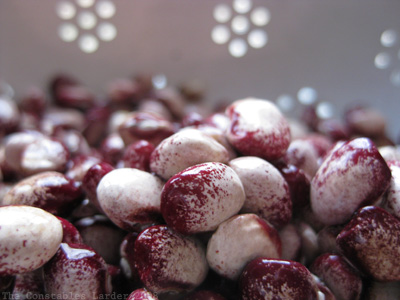
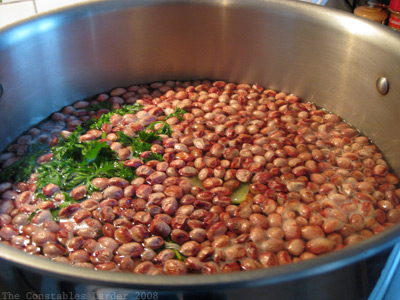
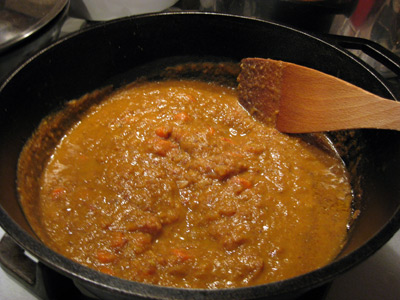

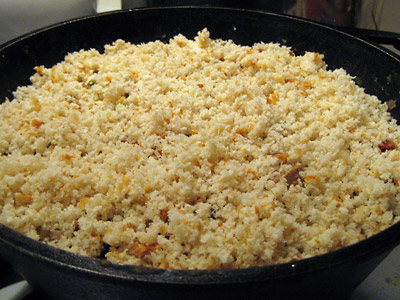
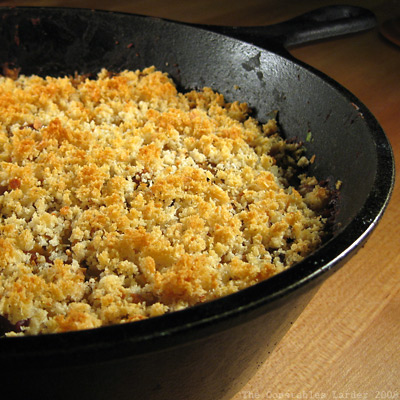
This looks sooooo yummy…are red nightfall beans available in OZ do you know? I have never heard of them, but have one supplier that may have! PLS Let me know.
This looks totally awesome! Thanks for sharing the recipe! 🙂
This really does look great! So, I’m thinking I need to try my hand at something like this…maybe I’ll make up my own recipe – who knows – looks REALLY great though!
-DTW
http://www.everydaycookin.blogspot.com
I had not come across red nightfall beans until very recently myself, Tenina! I liked them quite a bit, but think there are lots of bean types that would work really well with this dish.
Thanks for comments ya’ll. 🙂
That certainly looks like a dish we would love on a cold MN winter night. I wonder how the cranberry beans I got from the Rancho Gordo at the San Francisco farmer’s market would work in it.
Hi Kat – I was thinking that the rancho gordo cargamanto cranberry beans might be a better fit than traditional borlotti, since Sando describes them as thinner skinned. (but I’d probably just use whatever I had on hand, who am I kidding)
Am I still allowed to say it?
There are those BEANS again!
There, I said it.
This looks excellent.
You need to rename the blog.
Constables’ Comfort Food!
Can I come live at yours? Please? I’m pretty sure you need a French person to vouch for the (undisputable) excellence of your cassoulet. I can be that person. Pick me!
Claire, I think you are right. Definite vouching is required. I hope I pass muster (but I admit to being very happy with the results of this one).
Of course, as Stacey noted, I am a sucker for them beans.